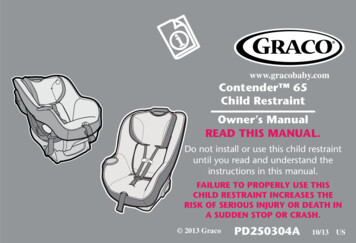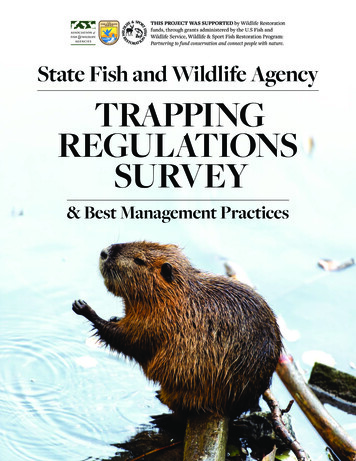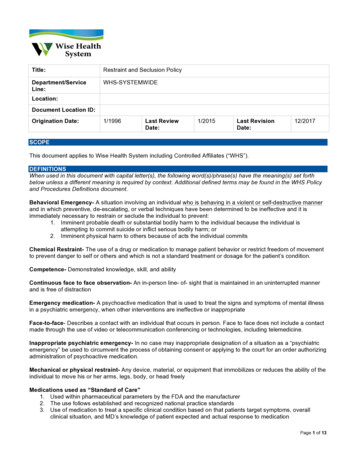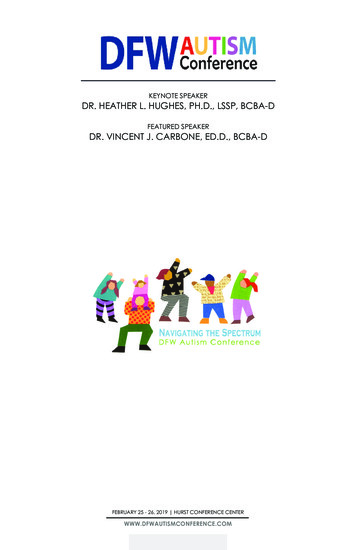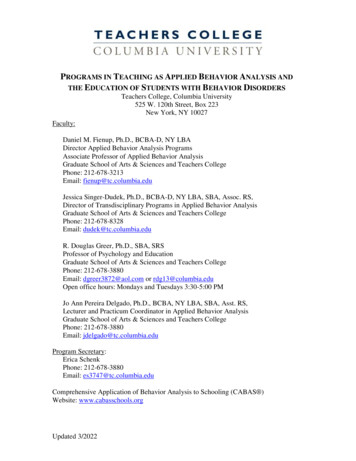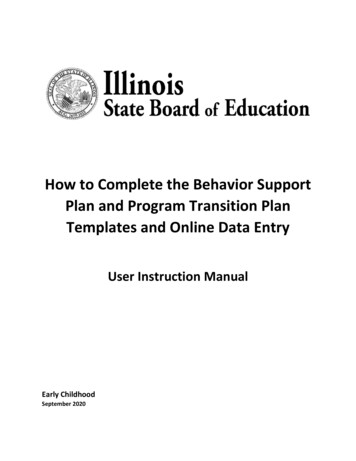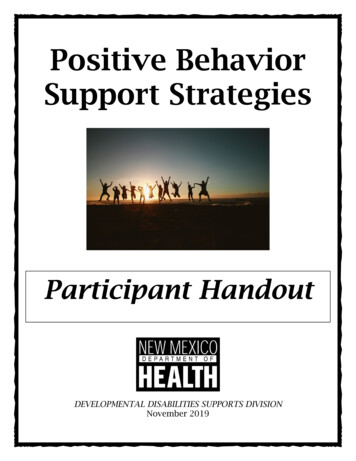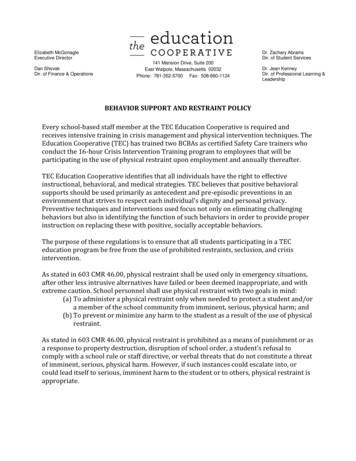
Transcription
Elizabeth McGonagleExecutive DirectorDan ShovakDir. of Finance & OperationsDr. Zachary AbramsDir. of Student Services141 Mansion Drive, Suite 200East Walpole, Massachusetts 02032Phone: 781-352-5700 Fax: 508-660-1124Dr. Jean KenneyDir. of Professional Learning &LeadershipBEHAVIOR SUPPORT AND RESTRAINT POLICYEvery school-based staff member at the TEC Education Cooperative is required andreceives intensive training in crisis management and physical intervention techniques. TheEducation Cooperative (TEC) has trained two BCBAs as certified Safety Care trainers whoconduct the 16-hour Crisis Intervention Training program to employees that will beparticipating in the use of physical restraint upon employment and annually thereafter.TEC Education Cooperative identifies that all individuals have the right to effectiveinstructional, behavioral, and medical strategies. TEC believes that positive behavioralsupports should be used primarily as antecedent and pre-episodic preventions in anenvironment that strives to respect each individual's dignity and personal privacy.Preventive techniques and interventions used focus not only on eliminating challengingbehaviors but also in identifying the function of such behaviors in order to provide properinstruction on replacing these with positive, socially acceptable behaviors.The purpose of these regulations is to ensure that all students participating in a TECeducation program be free from the use of prohibited restraints, seclusion, and crisisintervention.As stated in 603 CMR 46.00, physical restraint shall be used only in emergency situations,after other less intrusive alternatives have failed or been deemed inappropriate, and withextreme caution. School personnel shall use physical restraint with two goals in mind:(a) To administer a physical restraint only when needed to protect a student and/ora member of the school community from imminent, serious, physical harm; and(b) To prevent or minimize any harm to the student as a result of the use of physicalrestraint.As stated in 603 CMR 46.00, physical restraint is prohibited as a means of punishment or asa response to property destruction, disruption of school order, a student’s refusal tocomply with a school rule or staff directive, or verbal threats that do not constitute a threatof imminent, serious, physical harm. However, if such instances could escalate into, orcould lead itself to serious, imminent harm to the student or to others, physical restraint isappropriate.
The Education Cooperative’s use of physical restraint supports the following regulatoryprinciples: Least Restrictive Interventions: The curriculum for physical management isorganized in a “least-to-most” restrictive manner. The use of positive behavioralsupports and antecedent strategies are implemented prior to determining that asituation warrants the use of physical restraint. Students have the right to be free from restraints: The use of restraint is allowed onlyif necessary for immediate safety. Student have the right to be free from verbal, sexual, physical, mental, and emotionalabuse or harm: Staff are provided with a safe and comprehensive set of skills toreplace practices that might otherwise lead to abuse.As stated in 603 CMR 46.00, The use of mechanical, medication, or seclusion restraint is prohibited.o Mechanical restraint shall mean the use of any device or equipment torestrict a student's freedom of movement. The term does not include devicesimplemented by trained school personnel, or utilized by a student that havebeen prescribed by an appropriate medical or related services professional,and are used for the specific and approved positioning or protectivepurposes for which such devices were designed. Examples of such devicesinclude: adaptive devices or mechanical supports used to achieve properbody position, balance, or alignment to allow greater freedom of mobilitythan would be possible without the use of such devices or mechanicalsupports; vehicle safety restraints when used as intended during thetransport of a student in a moving vehicle; restraints for medicalimmobilization; or orthopedically prescribed devices that permit a student toparticipate in activities without risk of harm.o Medication restraint shall mean the administration of medication for thepurpose of temporarily controlling behavior. Medication prescribed by alicensed physician and authorized by the parent for administration in theschool setting in not medication restraint.o Seclusion shall mean the involuntary confinement of a student alone in aroom or area from which the student is physically prevented from leaving.Seclusion does not include a time-out as defined in 603 CMR 46.02. Floor or prone restraints are prohibited.o Prone restraint shall mean a physical restraint in which a student is placedface down on the floor or another surface, and physical pressure is applied tothe student's body to keep the student in the face-down position.As stated in 603 CMR 46.00, the following terms shall have the following meanings:1. Extended restraint: If a student is restrained for a period longer than 20 minutes,program staff shall obtain the approval of the Program Director. The approval shallbe based upon the student's continued agitation during the restraint justifying theneed for continued restraint.2. Physical escort: a temporary touching or holding, without the use of force, of thehand, wrist, arm, shoulder, or back for the purpose of inducing a student who isagitated to walk to a safe location.
3. Physical restraint: shall mean direct physical contact that prevents or significantlyrestricts a student's freedom of movement. Physical restraint does not include: briefphysical contact to promote student safety, providing physical guidance orprompting when teaching a skill, redirecting attention, providing comfort, or aphysical escort.The Education Cooperative implements physical restraint with extreme caution. Trainingfor all staff working directly with students is provided by a certified trainer. Prior tolearning physical management techniques staff are explicitly taught prevention and deescalation procedures. Additionally, staff are instructed on relationship building techniquesand other methods of preventing the need for physical restraint. Such procedures aredrawn primarily from the field of Applied Behavior Analysis (ABA). All staff are informedof, tested, and experience hands-on role plays regarding the increased risk of injury to astudent when an extended restraint is used, administering physical restraint in accordancewith known medical or psychological limitations and/or behavioral intervention plansapplicable to an individual student, monitoring of physical and emotional distress, and howto obtain medical assistance if necessary.Required training shall be provided to each staff as appropriate within their first month ofhire. Re-certification will be completed annually for all trained staff. The due date for recertification is one year from the first day of the initial training. Certification lapsesimmediately if certification is not completed. A 90-day grace period is in effect to allow thestaff to complete their re-certification training after their due date. However, they are notcertified to implement physical restraint procedures until re-certification is completed. Ifthe 90-days expire staff must complete the initial certification class rather than theabbreviated recertification in order to once again be in compliance.TEC Education Cooperative staff physically intervene during a crisis only if, in theirjudgment, an individual’s behavior is creating a situation that is more dangerousthan the danger of using physical intervention. No restraint will be administered in such a way that the student is prevented frombreathing or speaking. During the administration of a restraint, a staff member will continuously monitorthe physical status of the student, including skin color and respiration. A restraintwill be released immediately upon a determination by the staff memberadministering the restraint that the student is no longer at risk of causingimminent physical harm to him or herself or others. Restraint will be administered in such a way so as to prevent or minimizephysical harm. If, at any time during a physical restraint, the studentdemonstrates significant physical distress, the student will be released from therestraint immediately, and staff will take steps to seek medical assistance. Staff will review and consider any known medical or psychological limitationsand/or behavioral intervention plans regarding the use of physical restraint onan individual student. Following the release of a student from a restraint, the staff will implementfollow-up procedures. These procedures include reviewing the incident with
the student to address the behavior that precipitated the restraint (whendeemed appropriate to do so), reviewing the incident with the staff person(s)who administered the restraint to discuss whether proper restraint procedureswere followed, and consideration of whether any follow-up is appropriate forstudents who witnessed the incident.Parents or guardians must be informed of all restraints involving their children,regardless of duration. The TEC Program Director or designee will contact parentsor guardians within the same school day of the incident(s) to inform them of therestraint.All instances of physical restraint will be documented and available for review bythe Department of Elementary and Secondary Education upon request. Individualstudent logs will be maintained and be available for review by the student’s Districtand Parents or Guardians upon request.Food and/or drinks are never withheld from students. If the student has notregrouped sufficiently to participate in instructional activities, regularly scheduledschool work, related services, or clinical services, food and/or drink will be broughtto the student.As stated in 603 CMR 46.00, when a restraint has resulted in a serious injury to astudent or program staff member or when an extended restraint (20 consecutiveminutes) has been administered, the program shall provide a copy of the writtenreport required by 603 CMR 46.06(4) to the Department of Elementary andSecondary Education within five school working days of the administration of therestraint. The program shall also provide the Department with a copy of the recordof physical restraints maintained by the program administrator pursuant to 603CMR 46.06(2) for the thirty-day period prior to the date of the reported restraint.The Department shall determine if additional action on the part of the publiceducation program is warranted and, if so, shall notify the public education programof any required actions within thirty calendar days of receipt of the required writtenreport(s).Staff at The Education Cooperative are mandated reporters. Any injury that staffmembers have “reasonable cause” to believe resulted from abuse or neglect must beverbally documented and written pursuant of TECs Child Abuse Policy.
Student Protective Management FormName of Student(s):School Name:TEC Program Name:Location(s) of Incident:Date of Incident:Start Time/End Time/length ofprocedure:Reported By:Staff involved in ProtectiveManagement:De-escalation Procedures attempted before the Protective ManagementIdentify the type of protective management used by placing a number to the left of the technique, in theorder in which they were attempted. Use blank spaces for other de-escalation procedures used.Provided choicesUse of reinforcement programUsed Safety Stance andElbow CheckProvided sensory inputRemoved potentiallyUsed the Help Strategydangerous items from the"What do you need?"areaVerbal redirectionReduced verbal interactionUsed the Prompt Strategy"Touch head, toes."Calming techniquesBrought to quiet area withinUsed the Wait Strategythe room: Non-ExclusionaryTime-OutReduced demandsBrought to room away fromUsed supportive guidepeers: Exclusionary Time-OutStaff ChangeAntecedent Events-Triggers and Signals:Where was the student?IncidentWho (initials of peers; staff names) was with the student?Were there other disruptions in the area (announcements over the loud speaker; other studenthaving behavioral problems, etc.)?What was the student doing IMMEDIATELY prior to the behavior that resulted in protectivemeasurements?What behavior was exhibited that resulted in the use of Protective Management by staff?Page 1
Protective ManagementIdentify the type of protective management used by placing a number to the left of the technique, in theorder in which they were used.1 – Person Stability Hold1-Person Stability Hold –1-Person Stability Shuffleseated on floor2-Person Stability Hold2-Person Stability Hold2 - Person Forward Escortseated on floor2-Person Stability Hold2 – Person Stability Escortseated in chairPost-Incident ResponseHow was the incident resolved? What injury(ies) occurred, if any? Describe medical follow up. Who fromTEC administration was informed of the incident and when/how did this occur? Were parents contacted? Ifso, by whom? Was the student involved in a debriefing? If so, what was discussed? Attach student debriefingreport if necessary.Behavioral Services Follow-upHas this behavior been assessed previously? Is this a targeted behavior / response that is in the studentscurrent Behavior Support Plan (BSP)? Are there other techniques that may be more effective?Date of follow up with staff:Page 2
Critical Incident Report FormName of Student(s):School Name:TEC Program Name:Location(s) of Incident:Date of Incident:Start Time and End Time:Reported By:Staff involved with student at time ofincident:Triggers and SignalsWhat factors occurred before the incident. Consider both triggers (what was happening in theclassroom, what was the student doing, what were other people doing, etc.) and signals (whatantecedent behaviors did the student show before the incident occurred such as pacing, noncompliance, verbal statements, etc.) Also state the duration of this phase.Incident SummaryDescribe the incident in detail. Describe behavior or action of student, how staff membersresponded, duration of incident, etc.Post-Incident ResponseHow was the incident resolved? What injury(ies) occurred, if any? Describe medical follow up. Whofrom TEC administration was informed of the incident and when/how did this occur? Were parentscontacted? If so, by whom? Was the student involved in a debriefing? If so, what was discussed?Attach student debriefing report if necessary.Behavioral Services Follow-upHas this behavior been assessed previously? Is this a targeted behavior / response that is in thestudents current Behavior Support Plan (BSP)? Are there other techniques that may be moreeffective?Date of follow up with staff:
East Walpole, Massachusetts 02032 Phone: 781-352-5700 Fax: 508-660-1124 . o Medication restraint shall mean the administration of medication for the . Secondary Education within five school working days of the administration of the restraint. The program shall also provide the Department with a copy of the record

